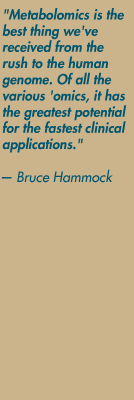|
METABOLOMIC FINGERPRINT
Why a distinguished bug man wants your metabolite
profile
 |
 |
| |
Metabolites offer clues that may help scientists de-bug cancer mysteries. |
 |
 |
Bruce Hammock is a rare hybrid: A cancer researcher whose training is in entomology, the study of insects.
A member of the UC Davis entomology
faculty since 1980, the distinguished professor has made insect science the jumping-off point for a career
devoted to basic questions in biology and biochemistry, from mammalian xenobiotic metabolism to the development
of recombinant viral pesticides. In 1999, his body of work earned him a seat on the National Academy of
Sciences, one of the highest honors that can be accorded a scientist in the United States.
Today Hammock's considerable talents focus on metabolomics, the 'omics discipline
he predicts will be the first to yield advances in the clinic. One of his first targets: prostate cancer.
Defining metabolites
A metabolite is any product of metabolism. Doctors have been able to measure a couple dozen metabolites
in blood and urine specimens for years. Uric acid, left over when certain proteins in foods are metabolized,
is just one example. Too much of this metabolite in the blood can signal gout, too much in the urine can
signal kidney stones. Beyond uric acid, scientists believe there are perhaps 3,000 other metabolites present
in our bodies, the vast majority still to be identified.
Hammock and other scientists hope to identify the most important of these, and determine what they signify.
Ultimately the knowledge could enable doctors to take our metabolomic "fingerprints," complex profiles
of metabolite levels and patterns that may open up a new era in clinical diagnosis.
For example, Hammock is betting that prostate cancer cells leave their own trail of tell-tale metabolites.
With Katja Dettmer, a post-graduate fellow in his lab, he plans to systematically map the metabolic profiles
of a diverse selection of prostate cell lines: some derived from highly aggressive prostate cancers, some
taken from very slow-growing prostate tumors, and others harvested from healthy prostates. The task is
made possible by advances in technology, pioneered in Hammock's lab, which allow analysis of thousands
of metabolites at a time.
Prostate cancer test?
Hammock's hope: to develop a simple metabolite test that would allow urologists to accurately distinguish life-threatening prostate tumors from those unlikely to grow beyond the prostate itself.
Such a test would spare thousands of men with indolent prostate cancers the risks and side-effects of
aggressive treatment, while ensuring that men with life-threatening tumors get the most aggressive therapy
possible.
And if metabolomics yields new tools to fight prostate cancer, tools for other cancers no doubt will
follow.
"The beauty of this field is that once you have a good system in place, you can apply it to any problem,"
Dettmer says.
Metabolomics is a hot topic throughout the UC Davis Integrated Cancer Research Program, a network of
more than 240 scientists on the Davis campus, at the medical center in Sacramento and at Lawrence
Livermore National Laboratory in Livermore.
Secret factories
Like Hammock, Rod Balhorn, a biochemist at Lawrence Livermore, believes the end-products of cell activity
— the metabolites — may provide the quickest and most useful ways to monitor cellular function.
Balhorn likens metabolomics researchers, trying to discover how a cell works, to intelligence agents,
trying to figure out what a secret factory does."Let's say the factory makes buckets," he suggests. "You
could look in the factory's office at the enormous catalogue of machines available for use; that's equivalent
to the factory's 'genome.'"
"But if you took this approach, it would take a very long time to learn anything about what was going
on in the factory."
"Or, you could examine all the machines that are actually present in the facility. They would correspond
to the proteins in the cell. Upon looking carefully at each one, you might discover that one machine cuts
sheets of metal, another rolls the pieces into a cylinder, and another fuses the edges together."
This would make it possible to more easily guess what the factory might be doing, but there would still
be a lot of different possible answers."Or, you could simply look at the factory's end product: the bucket.
The bucket would be analogous to the metabolite of the cell — the product of all the activity," he says.
Finding the bucket
If finding the bucket is the easiest way to figure out what the factory is doing, finding metabolites
may be the easiest way to figure out what individual proteins do, Balhorn says. The approach has tremendous
potential for advances in understanding, preventing and treating cancer and other diseases.
Says Hammock: "Metabolomics is the best thing we've received from the rush to the human genome.
Of all the various 'omics, it has the greatest potential for the fastest clinical applications."
|



